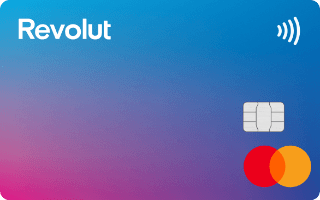The financial landscape is changing as “challenger banks” and e-money account providers like Revolut and Monese take on traditional high street banks. These mobile-only e-money accounts are offering customers a far quicker, easier experience. Gone are the days of going into your bank to open an account, or calling up your bank to report your card stolen. In this guide we take in-depth look at Revolut and Monese, helping you compare the pair.
Revolut vs Monese: Vital statistics
With the free Revolut account (its “Standard” plan) you receive a blue and pink two-tone card, while with the free Monese account (its “Simple” plan) you get a white card with a blue logo.
Neither provider has branches, but you can deposit money into your Monese account at Post Office counters or PayPoints, although there is a 3.5% fee (with a minimum charge of £3) for doing this. Revolut doesn’t accept any cash deposits.
You won’t get any interest on your account balance with either brand, and you can’t apply for any overdrafts either.
Revolut and Monese don’t have UK banking licences, which means neither company is covered by the Financial Services Compensation Scheme (FSCS), which protects individual customer funds up to the value of £120,000. But both firms are registered with the FCA as electronic money institutions, which means customer funds must be kept in a separate account at a licensed UK bank, so the money is ring-fenced should the companies go under.
In Finder’s 2025 Banking Customer Satisfaction Awards, Revolut scored 4.5 out of 5, with 93% of its customers saying they would recommend one of its e-money accounts. Monese scored 3.7 out of 5 stars, with 67% of its customers saying they would recommend one of its e-money accounts.
Finally, Revolut currently runs a number of welcome promotions including a sign-up bonus for new customers where if you open an account, you can receive £20.
Round 1: App features
Revolut and Monese both come with a wide variety of features in their mobile apps, allowing you do very similar things. Both have spending categories, where your transactions are automatically placed into an appropriate category, such as bills or transport. Although with Revolut you can create and customise your categories, whereas with Monese they are pre-set as 15 “lifestyle categories”.
You can also analyse your weekly or monthly spending insights in both apps, which helps you set budgets, as well as receive alerts when payments go out of your account.
Revolut’s “Vaults” and Monese’s “Pots” let you set money aside for specific goals, like saving up for a holiday or a shopping treat. Both also offer “round-ups”, where spare change from your transactions can be rounded up and put into your savings bucket.
You can pay your salary into either your Revolut or Monese account, manage direct debits and make international payments. You can freeze or unfreeze your card in the apps, as well as contact both customer service teams through the in-app chats, although neither challenger operates a telephone helpline where you can speak to someone in person.
You can’t pay cheques into either your Revolut or Monese account, digitally or otherwise.
- Winner: Revolut. As you can see from our table above, this pair’s feature options are basically the same, so there is very little to choose between them here. But if we had to be picky, Revolut does have the slight advantage of customisable spending categories and cheaper international transfers.
Round 2: Spending in the UK
 |  | |
| Free card transactions in the UK | ||
| Contactless card limit | £100 | £100 |
| Apple Pay | ||
| Google Pay | ||
| Samsung Pay | ||
| Free ATM withdrawals | Limited to £200 per month or 5 withdrawals | 2% per withdrawal |
| Find out more |
Spending on your Revolut or Monese card is free in the UK, and both cards currently have the standard contactless limit of £100.
You can also add your Revolut card or Monese card to Apple Pay and Google Pay, but neither brand supports Samsung Pay.
With Revolut you can make up to 5 ATM withdrawals or take out £200 for free every month – whichever of those limits you hit first will trigger the subsequent charge of 2% on each following withdrawal (with a minimum fee of £1).
With Monese, ATM withdrawals incur a 2% fee.
- Winner: Revolut. It has free allowances, even though they’re limited. Monese will charge for all cash withdrawals.
Round 3: Using the card abroad
 |  | |
| Free foreign transactions | Limited to £1,000 per month | 2% fee |
| Free foreign ATM withdrawals | Limited to £200 per month | £1.50 fee |
| Find out more |
Those with a Revolut card can use it to make purchases abroad for free on weekdays, up to a monthly limit of £1,000 (then a 0.5% fee kicks in). They can also use the card to withdraw money abroad for free on weekdays, up to a monthly limit of £200 (after which there’s a charge of 2%). But on the weekends, a separate mark-up of 0.5% also applies to both card spending and cash withdrawals overseas (Revolut says this is because the international money markets close over the weekend). That 0.5% mark-up relates to all the major currencies, but for some minor currencies it rises to 2%.
With Monese, card spending abroad has a 2% charge. There’s also a 2% ATM withdrawal fee.
- Winner: Revolut. It’s a close call, but Revolut shades it here for its free spending allowance and cash withdrawal, even though they’re limited amounts.
Round 4: Account types
 |  | |
| Free account | ||
| Premium account | ||
| Joint account | ||
| Teen account (for 16- and 17-year olds) | ||
| Kids' account or card | ||
| Business account | ||
| Find out more |
Revolut and Monese both offer free e-money accounts, which are the main focus of this comparison guide. Revolut has also expanded its e-money account range with 4 paid-for tiers – Plus, Premium, Metal and Ultra. While Monese offers 2 paid-for accounts, in the form of Classic and Premium. Both brands also run business accounts.
Revolut doesn’t offer joint accounts or teen accounts, but does have a child account called Revolut Junior (managed through the parent’s account). Monese does offer joint accounts, but it doesn’t operate teen or child accounts.
- Winner: Revolut. It has a wider range of options, even though both have free and premium e-money accounts options, plus business accounts.
Round 5: Signing up
 |  | |
| Apply through the app | ||
| Quick application | ||
| Credit check | ||
| Card delivery fee | £4.99 | £4.95 |
| Card delivery timescale | Up to 9 working days | 3-5 business days |
| Find out more |
You can apply for either a Revolut or a Monese account through their mobile apps in just a few minutes. There are no credit checks, although a photo of your ID and a selfie photo or video is required. The accounts are then usually opened on the same day and both the cards are sent through the post.
Revolut charges £4.99 for card delivery, with the card taking up to 9 working day to arrive. Monese charges an almost identical £4.95 for delivery, and the card should be with you between 3–5 working days.
- Winner: Tie. It’s quick and easy to open either a Revolut or Monese account by downloading and then applying through their respective mobile apps. Both charge just a shade under £5 to have your card delivered.
Round 6: Access to extra benefits
Both Revout and Monese offer free euro accounts to run alongside your UK e-money account.
Monese also has a “marketplace” where its customers can sign up to financial products from its chosen partners. These include Raisin for interest-paying savings accounts, and Monevo for credit-related products. There’s also the option to link up to your PayPal account, which then allows you to track your PayPal transactions and balance through the Monese app.
Revolut doesn’t operate a marketplace, but it does have some unusual features of its own. You can trade shares or buy gold and silver (although there are fees involved for Standard account holders, and remember your capital is at risk if you decide to invest).
- Winner: Tie. This really depends on what extra features it is you’re after. For some, the savings and credit products available through the Monese marketplace will be the most important options, while for others, Revolut’s ability to trade shares and buy precious metals will win out.
Round 7: Customer reviews
On Trustpilot, Revolut has a score of 4.4 out of 5 from over 190,000 reviews. Monese has a score of 4.2 out of 5 from 46,000 reviews. These were checked in March 2025.
Customers praised Revolut for its ease of use, though there were some complaints about accounts or transactions being frozen while they were under review.
Positive reviews said Monese works smoothly, but there were a few reviews that expressed frustration about issues with customer service.
In our 2025 Customer Satisfaction Awards, Revolut scored 4.5 out of 5, with 93% of its customers saying they would recommend it. Monese scored 3.7 out of 5 stars, with 67% of its customers saying they would recommend it.
Overall winner: Is Revolut better than Monese?
Revolut wins nearly all the categories, with Monese only managing to tie a couple. That’s because it offers a better product overall. With Revolut on the path to becoming a full bank in the UK, that gap is only going to grow larger.
They both offer more inclusions with their paid accounts, but even here Revolut offers more.
Sources
More guides on Finder
-
Monzo Max review: Is the account worth it?
Is the Monzo Max account worth applying for?
-
Is Monzo Perks worth it?
Are Monzo Perks, Monzo Max and Monzo Extra worth the money? See our analysis in this video review.
-
Best online-only banks in the UK
Online-only banks have some limitations, but they also tend to offer handy features that might convince you to switch.
-
How to withdraw cash from an ATM without your debit card
If you’ve forgotten or misplaced your bank card and need to take out cash, several options are available. From where to get cashback to what you need to take to a branch, here’s what you need to know.
-
How to get a prepaid debit card without ID
Prepaid cards are a good option for people who don’t have any traditional forms of ID. Discover what you could use instead.
-
BuildMyCreditScore review
Discover more about how BuildMyCreditScore works, which banks it connects to and how long it will take to improve your credit score.
-
Banks that allow you to pay cheques in online
Discover which banks let you pay in cheques online and how to do it.
-
Advantages and disadvantages of an overdraft
Find out more about the pros and cons of an overdraft.
-
Santander Edge Up review
Level up your cashback earning potential with the Santander Edge Up current account. Find out about its features and benefits in our review.
-
Monzo bank account and card review
Is Monzo’s app-only current account the right option for you? Read our review to get the low-down on all of the features of the account, its card and the app.



